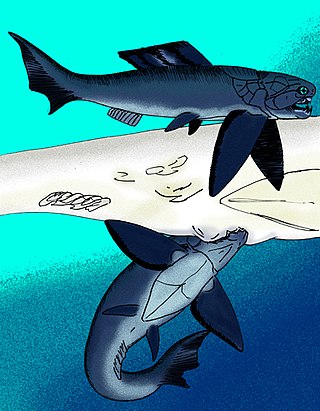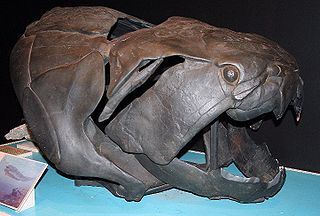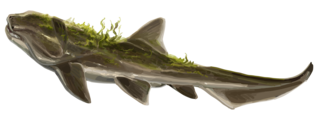
Dinichthys is an extinct monospecific genus of giant, marine arthrodire placoderm from the Late Devonian, comparable in size, shape, and ecological role to the better-known Dunkleosteus. Fossils were recovered from the Ohio Shale Formation along the Olentangy River in Delaware County, Ohio.

Brachythoraci is an extinct suborder of arthrodire placoderms, armored fish most diverse during the Devonian.

Rolfosteus is an extinct monospecific genus of arthrodire placoderm from the Early Frasnian stage of the Late Devonian period, found at the Gogo Formation of Western Australia.

Bruntonichthys is an extinct monospecific genus of arthrodire placoderm from the Early Frasnian stage of the Late Devonian period. Fossils are found in the Gogo Formation of the Kimberley region of Australia. The skull is about 139 millimetres long, and had proportionally large eye sockets. Researchers suggest it may have preyed on small mollusks.

Fallacosteus is an extinct monospecific genus of arthrodire placoderm from the Early Frasnian stage of the Late Devonian period, found at the Gogo Formation of Kimberley, Western Australia. As with almost all other camuropiscids, F. turneri had an elongated snout that may have enhanced its hydrodynamic streamlining.

Camuropiscis is an extinct genus of arthrodire placoderm from the Early Frasnian stage of the Late Devonian period, found at the Gogo Formation of Kimberley, Western Australia. The species of Camuropiscis had a flattened, elongated snout that may have aided in enhancing its hydrodynamic streamlining.

Latocamurus is an extinct monospecific genus of flat-nosed arthrodire placoderm from the Early Frasnian stage of the Late Devonian period, found at the Gogo Formation of Kimberley, Western Australia.

Xiangshuiosteus wui is an extinct monospecific genus of brachythoracid arthrodire placoderm from the Late Emsian stage of the Early Devonian epoch, discovered in Wuding County of Yunnan province, China. It has recently been reassessed as a dunkleosteid.

Dunkleosteoidea is an extinct superfamily of arthrodire placoderms that lived during the Devonian period. The gigantic apex predator Dunkleosteus terrelli is the best known member of this group.

Heterosteus is an extinct genus of heterosteid placoderm of the Middle Devonian known from remains discovered in Europe and Greenland. According to Denison, 1978, Heterosteus might have been planktivorous, along with Homosteus, and Titanichthys.

Herasmius is an extinct genus of heterosteid placoderm from the Devonian period. Fossils have been discovered freshwater deposits in Norway and Canada.

Pachyosteomorphi is an extinct clade of arthrodire placoderms within the Eubrachythoraci, armored fish most diverse during the Devonian. Most are considered to be pelagic long-distance swimmers, leading to their widespread distribution beginning from at least the Middle Devonian period.

Panxiosteidae is an extinct family of arthrodire placoderms that lived during the Devonian period.
Panxiosteus is an extinct monospecific genus of placoderm arthrodire from the Middle Devonian: Givetian stage of Yunnan province, China.

Coccosteomorphi is an extinct clade of arthrodire placoderms within the Eubrachythoraci, armored fish most diverse during the Devonian. Most are considered to be pelagic long-distance swimmers, leading to their widespread distribution beginning from at least the Middle Devonian period.

Millerosteus is an extinct genus of coccosteid arthrodire placoderm from the Early Givetian stage of the Middle Devonian period. Fossils are found in the Orkneys and Caithness, Scotland.
Watsonosteus is an extinct genus of coccosteid arthrodire placoderm from the Late Givetian stage of the Middle Devonian period. Fossils are found in the Orkney Islands, Scotland.
Torosteus is an extinct genus of arthrodire placoderm from the Early Frasnian stage of the Late Devonian period. Fossils are found in the Kimberley region of Australia.

Trematosteus is an extinct monospecific genus of arthrodire placoderm from the Late Frasnian stage of the Late Devonian period. Fossils are found from Bad Wildungen, Germany.
Tapinosteus is an extinct monospecific genus of arthrodire placoderm from the Late Frasnian stage of the Late Devonian period. Fossils are found from Bad Wildungen, Germany.























